Metallica: Garage Daze
Thirty years ago, Metallica couldn’t have been further away from the stadium-packing behemoth they are today.
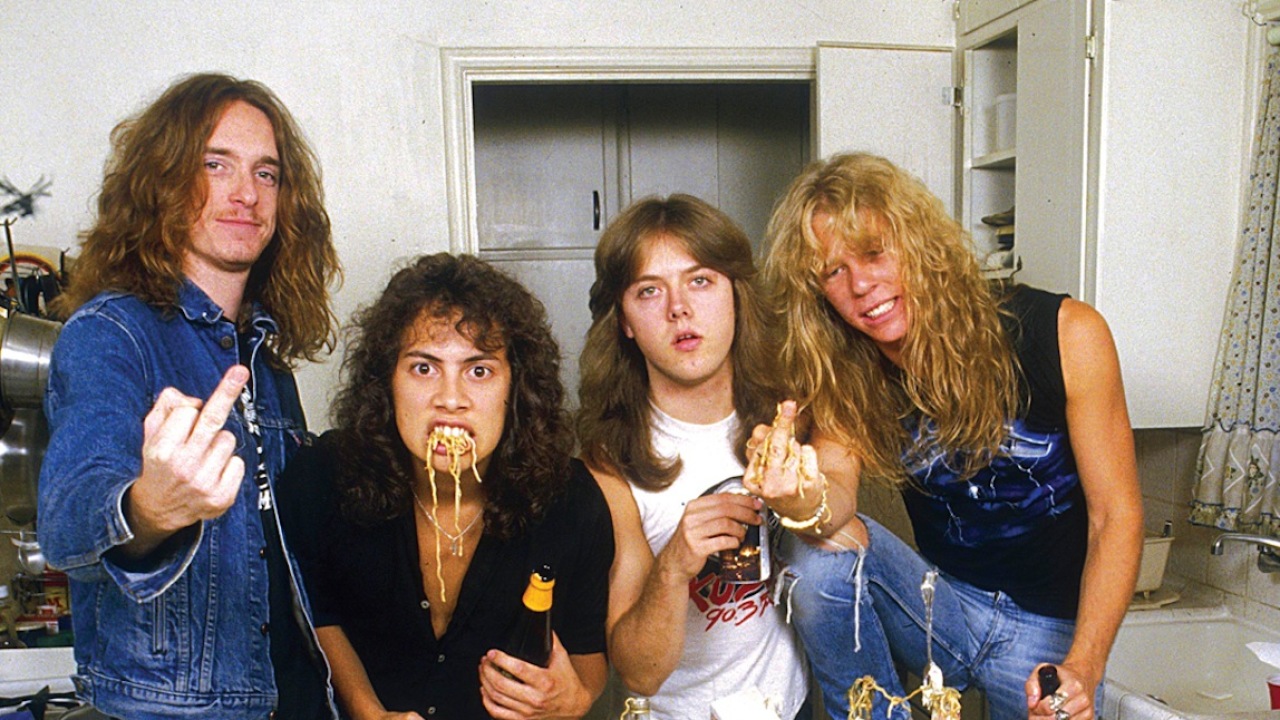
This article originally appeared in Metal Hammer #267.
As James, Lars and Kirk will attest, 1985 marked a seminal point in their career: 12 months that saw them drink, fuck and fight their way through metal’s lower ranks while getting on with the business of writing the greatest metal album of all time. Here, we revisit a band that was still hanging onto its roots as a true metal Band Of The People, while teetering precariously on the edge of glory…
As the final notes of Metal Militia melted into the night air, James Hetfield, Kirk Hammett, Cliff Burton and Lars Ulrich walked from the stage of London’s Lyceum venue with broad smiles on their sweat-drenched faces. Tonight, the applause and cheers ringing around the grand old ballroom sounded particularly sweet. In their hearts, the members of Metallica knew that date 26 of the Ride The Lightning European tour had been far from their finest show of 1984, but with it being their final show of the year, the four young musicians were elated; buoyed not only by the approval of the 2,000 metalheads gathered inside the Grade II-listed building, but by the very welcome prospect of their imminent return to their beloved San Francisco to join friends and family for the Xmas holidays.
By any measure, 1984 had been a year to remember for the young upstarts, a year in which the international buzz around their band had been amplified from a whisper to a scream. Following a cruel January setback when thieves in Boston had relieved the band not only of their guitars, amps and drumkit, but also of the truck used to transport said equipment from gig to gig, Metallica had rallied to record an acclaimed second album, had toured Europe twice, scored their first major magazine covers, signed a seven-album deal with Elektra Records in the US and secured big-time management with former AC/DC manager Peter Mensch’s Q Prime organisation.
It’s little wonder, then, that when Lars Ulrich spoke to the UK metal fanzine Metal Forces at the end of the year, the little Dane who’d willed Metallica into existence just three years earlier sounded so aggressively upbeat about the year to come./o:p
<!–[if gte mso 9]>
0 0 0
Sign up below to get the latest from Metal Hammer, plus exclusive special offers, direct to your inbox!
“Cliff Burnstein, who signed us to our new management deal in the States, has this big belief that what we are doing will be the next big thing in heavy metal,” he stated confidently. “I honestly believe that the kids who are into the Priest, Maiden, Kiss, and [Twisted] Sister will take onto what we’re doing. I’m not saying it’s something that’s going to happen overnight, but it could start developing and Metallica could be the frontrunners of a new branch of heavy metal.”
That, however, was for the future: on the night of December 20, 1984, Metallica had celebrating to do. As the four men opened their dressing room door, they were met with familiar faces and the unmistakable sound of champagne bottle corks being popped. The band’s UK label, Music For Nations, had chosen this moment to present their young charges with silver discs to commemorate some 60,000 sales of Ride The Lightning across Europe – an achievement all the more striking for the fact that Metallica had yet to release a promo video or so much as a seven-inch single. When label boss Martin Hooker passed a foaming bottle of fizz to James Hetfield, the 21-year-old singer – by reputation, the least housetrained of the defiantly unreconstructed quartet – took one swig from the bottle and, to raucous cheers, let out a huge, noxious belch. The party lasted until the morning sun ushered in the beginning of the winter solstice: Metallica’s homebound flight would be a rather more sober and sedate affair./o:p
<!–[if gte mso 9]>
0 0 0
As 1985 began, Metallica turned their attention from Europe to their homeland, a nation in which they had played just a handful of shows during the previous year. Ever attentive to the musical landscape, Lars Ulrich recognised his band had lost some momentum on home soil at the precise point where metal was gaining traction in the US, acknowledging to journalists that his band “may have lost a little ground to other bands”. This Metallica sought to rectify with the booking of a 50-date North American tour, taking in 19 states and Canada’s five largest cities, in the company of LA rockers WASP and Armored Saint. It would be Metallica’s longest tour to date. It would also be an undertaking on which the quartet cemented their reputation as the brightest stars on a resurgent US metal scene.
As the tour rolled from New York state to Philadelphia and Maryland before crossing into Canada, it became apparent that the caravan was attracting two separate audiences: those drawn to the showmanship, spectacle and schlock of headliners WASP, here representing the burgeoning ‘hair metal’ movement, and those who preferred their music rather more unrefined, aggressive and uncompromising, as typified by Metallica, and to a lesser extent, their friends in Armored Saint. If this division was not entirely a shock to Metallica – James and Lars had relocated from Los Angeles to San Francisco, after all, upon realising that Sunset Strip audiences were wholly indifferent to their raw, ferocious New Wave Of British Heavy Metal-inspired sound – it came as something of a revelation to WASP frontman Blackie Lawless, who regarded the nightly chaos in the rooms with some bemusement.
“It was like an invisible line [had been] drawn down the middle of the room,” he commented. “Half was theirs, half was ours. It didn’t matter what we were doing onstage. It looked like two opposing armies. Sometimes we just stopped what we were doing and watched.
“It was,” he recalled, “a war.”
For Metallica, the battle to win hearts and minds across America didn’t cease when their nightly set ended. Just as the US hardcore punk scene had spread across the nation a few years earlier, so underground metal was steadily gaining a foothold in the blue-collar cities and towns which formed metal’s heartland via tape-trading, fanzines such as The Headbanger, Metal Mania and Kick Ass Monthly and old fashioned word-of-mouth recommendations. Always his band’s most vocal and passionate supporter, the indefatigable Lars made it his mission nightly to get amongst the denim-and-leather clad adolescents who made up the tour’s core audience to spread the Metallica gospel, just as he’d done years earlier with the Bay Area ’bangers.
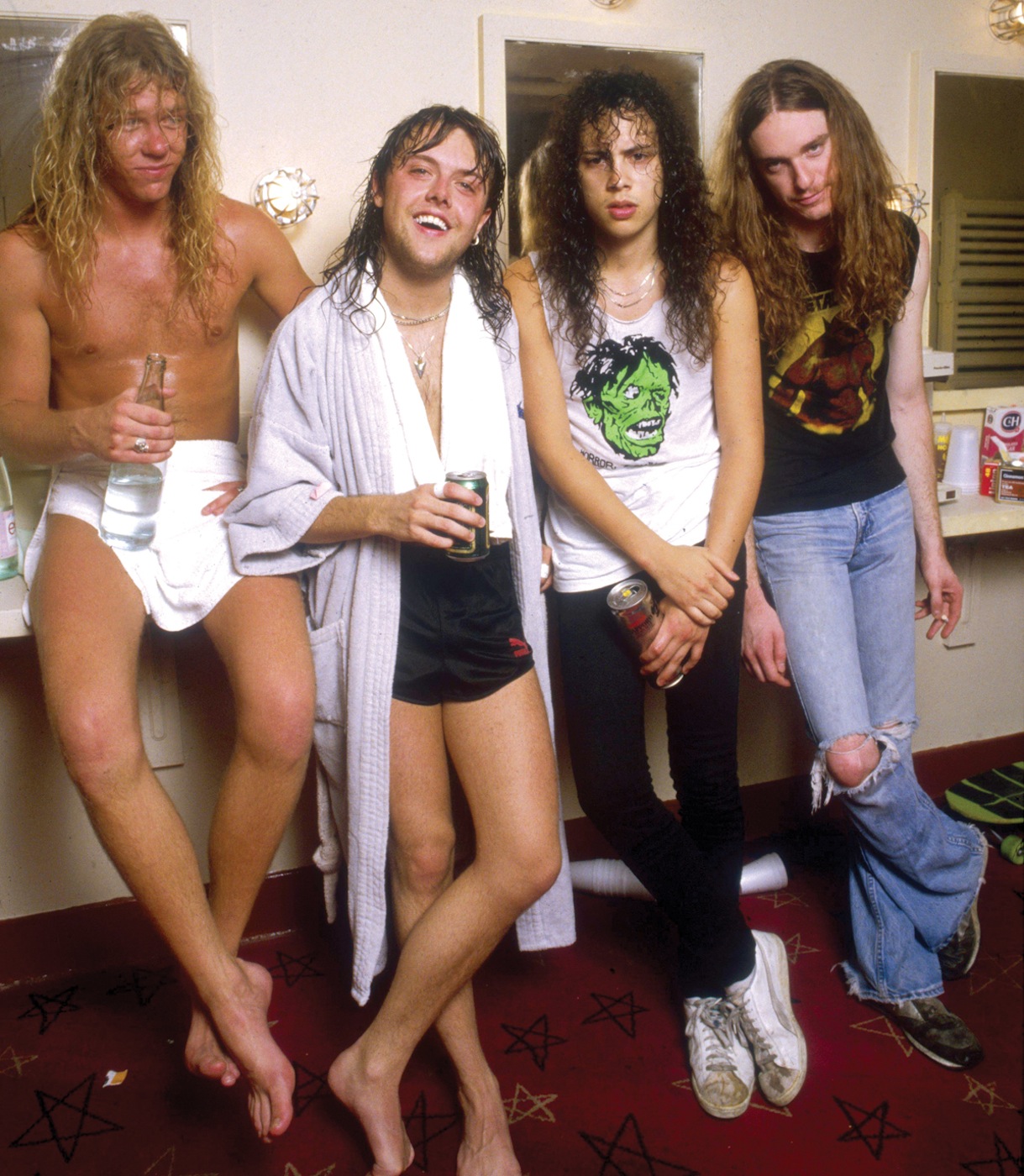
What meagre rider the band were allocated was shared among the Metallica ‘family’ – fans, fanzine writers and friends in bands such as Anthrax, Pantera, Anvil and Metal Church, plus whoever else might be drawn into Lars’s orbit. With drinks drained and confidence duly bolstered, inevitably, each night the members of Metallica would then turn their attention to the daughters of America.
“The major difference between Europe and America at that time was the girls,” Lars admitted. “In America girls were everywhere as soon as we started playing. On the Ride The Lightning tour, we’d done a run on Europe and maybe there were a couple of stragglers that showed up in Paris or Germany. Then we came to America and every show there were girls hanging around backstage and on the buses. It was every clichéd extravagance you can imagine.”
“Back then, we all shared stuff,” recalled James Hetfield. “’I did her. Dude, here! Have my chick.’ Lars would charm them, talk his way into their pants. Kirk had a baby face that was appealing to the girls. And Cliff… he had a big dick. Word got around about that, I guess.”
The band’s tour bus was christened ‘The Edna Express’, ‘Edna’ being the codename applied to any young lady willing to spend intimate moments, however fleeting, with the feral, pissed-up metalheads newly arrived in town.
“Girls would come on the bus and just blow the whole bus,” Lars ecalled. “Like, ‘OK, here’s two girls, everybody get in line.’ People would say, ‘Eww, she just blew that other guy…’ ‘So? You don’t have to put your tongue down her throat.’ We all had pretty good pulling power, but some of us got a little more desperate than others. There were certainly times where it was about quantity rather than quality.”
“Personal space was something of a rarity back then,” said Kirk . “We’d stay in one room, two to a bed. We all switched around, everyone shared a bed with everyone else at some point. Being in a bed with Cliff was difficult because he had the boniest elbows and knees. With Lars there was always a third party in the bed. That kept me awake…”
“It was just so cool to be away from home, playing music, drinking and being with your buddies, with no responsibilities at all,” Lars said years later. “That can’t survive, of course, but those are great days to look back on.”
On March 10, 1985, the tour rolled into LA for a sold-out show at the 4,000-capacity Hollywood Palladium. By then, WASP had jumped ship to support Iron Maiden (with whom they shared manager Rod Smallwood) on the English metal heroes’ World Slavery Tour, so Metallica graciously handed Armored Saint the opportunity to headline their biggest ever hometown show. It would prove to be something of a mixed blessing for John Bush’s band.
“This show was the only time I’ve ever seen a band annihilate a headliner,” recalls legendary rock photographer Ross Halfin, who was shooting the show for the now-defunct Sounds magazine. “Armored Saint just could not follow them. The first time I shot [Metallica] live was at the Lyceum and I thought they were so amateurish it was quite endearing and fun. [But that Palladium show] was the first time I really realised they were a serious force as a band.”
- Art: Lars Ulrich
- Five Of The Most Iconic Metallica Riffs
- Ulrich: I met Motorhead, then started Metallica
- The 10 Best Metallica Songs Featuring Cliff Burton
<!–[if gte mso 9]>
0 0 0
In July ’85, Halfin accepted an assignment from Q Prime’s Peter Mensch to shoot the band at home in San Francisco – or more specifically, the East Bay city of El Cerrito. He’d be quite unprepared for the sight that greeted him. From the moment that LA emigres James Hetfield and Lars Ulrich moved into 3132 Carlson Boulevard, a two-bedroom bungalow owned by Exodus manager Mark Whitaker, in February 1983, the property was transformed into an ‘anything goes’ heavy metal bachelor pad. Posters of Motörhead, UFO and Iron Maiden were tacked to the walls, beer cans and empty spirits bottled lay strewn in every corner, and the whole place smelled as if a corpse was hidden beneath the floorboards. It was a shithole, but it was Metallica’s shithole, and the house – the scene of Metallica’s very first practise session with Cliff Burton in 1982, now sarcastically dubbed the ‘Metallica Mansion’ – became infamous in the Bay Area and beyond as the scene’s premier party destination. Each and every night, the San Francisco ‘Trues’ – so-called because of their unswerving allegiance to ‘true’ metal acts such as Saxon, Priest and Maiden – would pile into the bungalow to continue the revelry started at thrash nights at dives such as Ruthie’s Inn and The Stone, and rage ’til dawn and beyond.
On the afternoon of July 25, Ross Halfin corralled the four bandmembers into the living room of the Metallica Mansion for a photo session. James, Lars, Kirk and Cliff squashed onto a filthy brown sofa beside a coffee table strewn with beer bottles, porn and that day’s edition of the San Francisco Examiner, the headline of which announced to its readers that [actor Rock] ‘Hudson Has AIDS’. The four unsmiling men regarded the visiting English snapper with expressions conveying nothing so much as pure disdain: in one celebrated still from the session, middle fingers are thrust defiantly into Ross’s lens. Here Metallica resemble a gang more than a band: four cocky little raggedy-arsed fucks with bad hair, bad skin and bad attitudes, with beer on their breath and the imminent prospect of violence on their minds. To the thousands of us teenage metal fans who’d view the image in years to come when it was chosen for the inner sleeve of the band’s third album, they looked like the coolest band in the world. Here, finally, was a band to believe in, a bunch of scruffy no-marks who looked Just. Like. Us. The big difference, however, was that none of us had spent the previous two months writing one of the greatest heavy metal albums of all time in the one-car garage at 3132 Carlson Boulevard…
“I’d like to say that there was something magical in the air in the summer we wrote Master of Puppets, something that hadn’t been there before and has never existed since,” Lars told Hammer as that landmark release celebrated its 20th anniversary. “But that would be a lie. I guess we just had the right attitude and the right openness to ideas. The whole band was getting more confident.
“Most of the record was written in May and June of 1985, from the best ideas that were kicking around on our riff tapes from the previous year. It really wasn’t any different this time than before – it’d basically be me and James sitting down with a bunch of tapes and sorting through the details of his ideas and my ideas and Kirk’s ideas. But Cliff had [also] been in the band for a few years and he brought in a lot of harmonies and melodies. It took a little while for James and I to open up to some of Cliff’s ideas about harmony and melody because we’d never played stuff like that before. But after a while we got it and that’s when we started experimenting more.”
Guitarist Kirk Hammett was a little more nostalgic as he recalled working on the group’s new songs in their El Cerrito garage. “When we started getting the songs together and rehearsing them, I can remember getting a huge lump in my throat, just from the emotion from playing these great tunes,” he recalled.
“There wasn’t anything left over from the Ride The Lightning stuff,” Kirk told biographer Mick Wall. “It was pretty much the definitive musical statement from that lineup, and it felt like it. We’d really gotten to know each other’s musical capabilities and temperaments over that three-year period, and I could tell it was really blossoming into something that was to be reckoned with. Every song we came up with was just the greatest thing. Every time we’d write another it was like, ‘Oh my God!’”
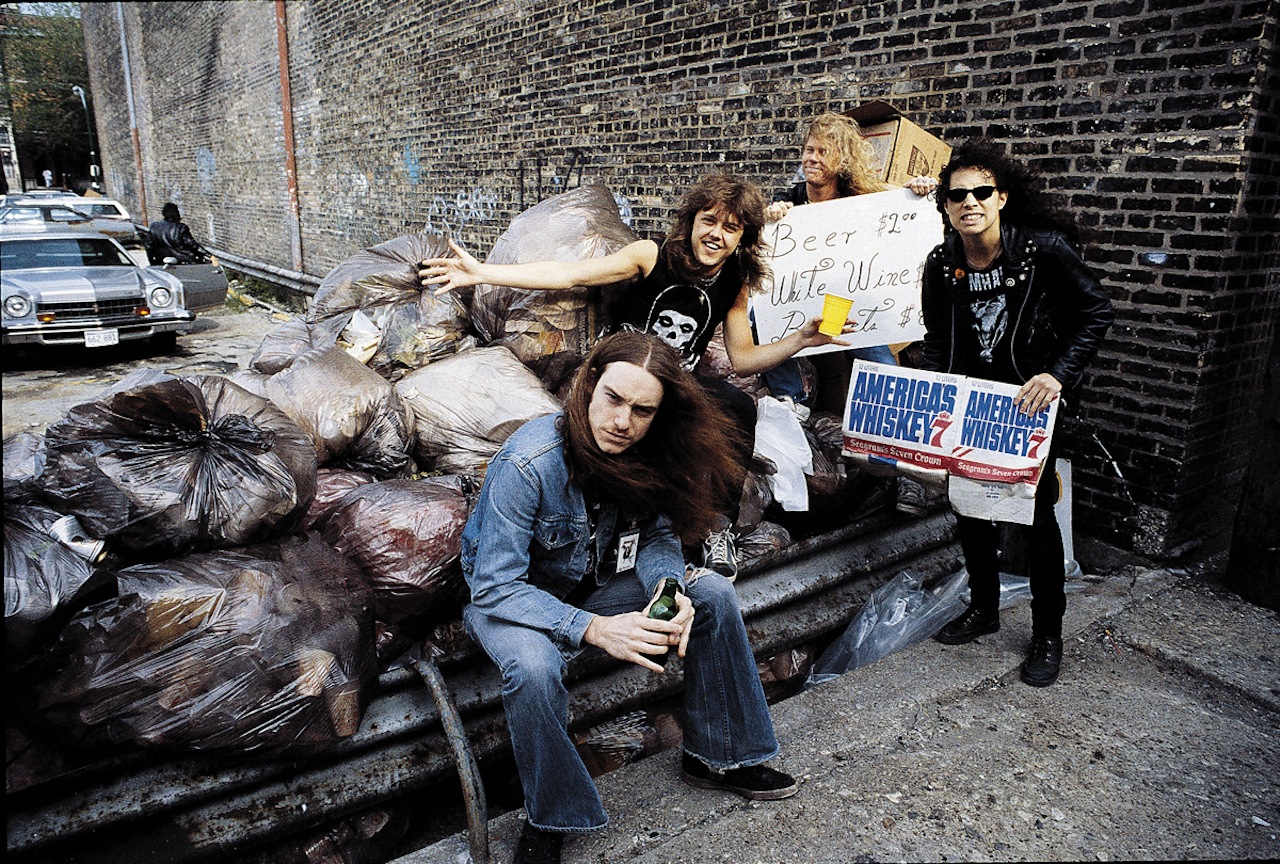
On September 1, James, Lars and Kirk left San Francisco International Airport, bound for Copenhagen: two days later, joined by Cliff at Sweet Silence studio and reunited with Ride The Lightning producer Flemming Rasmussen, they began work on what would be their third album.
As with the sessions which yielded Ride The Lightning, work upon the quartet’s third opus began at seven o’ clock each evening and stretched until the break of dawn. Before each shift commenced, though, the musicians would first eat dinner at the home Flemming shared with his wife, Permille, the producer recalling, perhaps with a little surprise, that his guests were “really quiet and really nice.” Equally impressive was the obvious progression each musician had made since they were last in the Dane’s company.
“They had made such massive strides,” remembers Flemming. “Technically, as musicians it was very obvious that they’d spent most of the time since we’d recorded Ride The Lightning on tour. It was very obvious that their technical abilities had really improved, especially Lars, who was just miles better than he was before.”
“Master Of Puppets is definitely a more uncommercial album than Ride The Lightning,” the producer argues. “Master Of Puppets is Metallica celebrating that they’ve got a major label deal and that they no longer give a shit. It was them saying, ‘We’re just going to do the stuff we like and if the record company doesn’t like it, then fuck them.’ I think that was the attitude. And it worked, too. There’s not one bad song on the album, not a single one. It is just fabulous from start to finish. They had that youthful attitude of ‘We’re better than everybody else in the whole world’ and they were just out to kick some ass.”
“I don’t remember anything particularly magical about making …Puppets,” Lars later reaffirmed to Hammer. “We had as many fights making Master Of Puppets as any other album. The currency exchange at the time meant that we could spend five months of studio time in Sweet Silence on our budget, but it wasn’t so easy for the three American gentlemen in the band to sit in Denmark in the dead of winter for all that time: Cliff got fed up with being in Copenhagen and went back to the States for a while. Then we were getting nowhere mixing the album with Flemming, so we asked Mark Whitaker to come over to help us out. There were no golden rainbows in the studio. Making that album definitely felt like a chore at times.”
Typical of his fastidious nature, Lars was the last member of Metallica to exit Sweet Silence. With Cliff having already flown the nest, on December 23 James and Kirk too returned home to San Francisco, leaving their drummer to celebrate the holiday with family in Denmark. On Boxing Day, the day of his 22nd birthday, Lars was back in the studio, working with Flemming on the final overdubs that would complete the recording process of Master Of Puppets. On December 27, a week shy of three months after entering the facility, the hardcore Danish pornography Metallica had taped to the walls of the studio was removed and the drummer set off for his adopted hometown, content that he had a “motherfucker” of a record in the can.
There was still band business to conclude, however, before the year drew to its close. On December 31, Metallica were booked to play the 7,000-capacity San Francisco Civic Auditorium, atop a bill which featured local heroes Exodus, Seattle’s Metal Church and Dave Mustaine’s Megadeth: on a hugely important night for Metallica, their first show with their former guitarist’s new band was of no little significance. This was a banner night for the emergent American thrash scene, nothing less than a coronation for its homecoming kings. Perhaps understandably, Dave Mustaine chose to mark the occasion by getting thoroughly trashed, though mouthing off to those in attendance about his new band’s potential to wipe the floor with any Bay Area act was a less than smart move, and one which earned the red-headed guitarist a hefty smack in the face from Exodus’s tour manager that left him in tears.
If Metallica were aware of the drama unfolding backstage, they gave no indication of giving the slightest sliver of a fuck about their former friend’s behaviour as they hit the stage ahead of the New Year chimes. After a furious No Remorse (a song Dave Mustaine might perhaps have heard with fresh ears), James Hetfield told the San Francisco crowd that the band would like to premiere a new song, one they had earmarked as the title track of their forthcoming third album.
The transcendent eight minutes that followed illustrated that Metallica were once again intent upon breaking new ground, not so much pushing the genre’s perceived boundaries as erasing them altogether. With a new year dawning, and Master Of Puppets ready to go, the future of metal lay squarely in their hands.
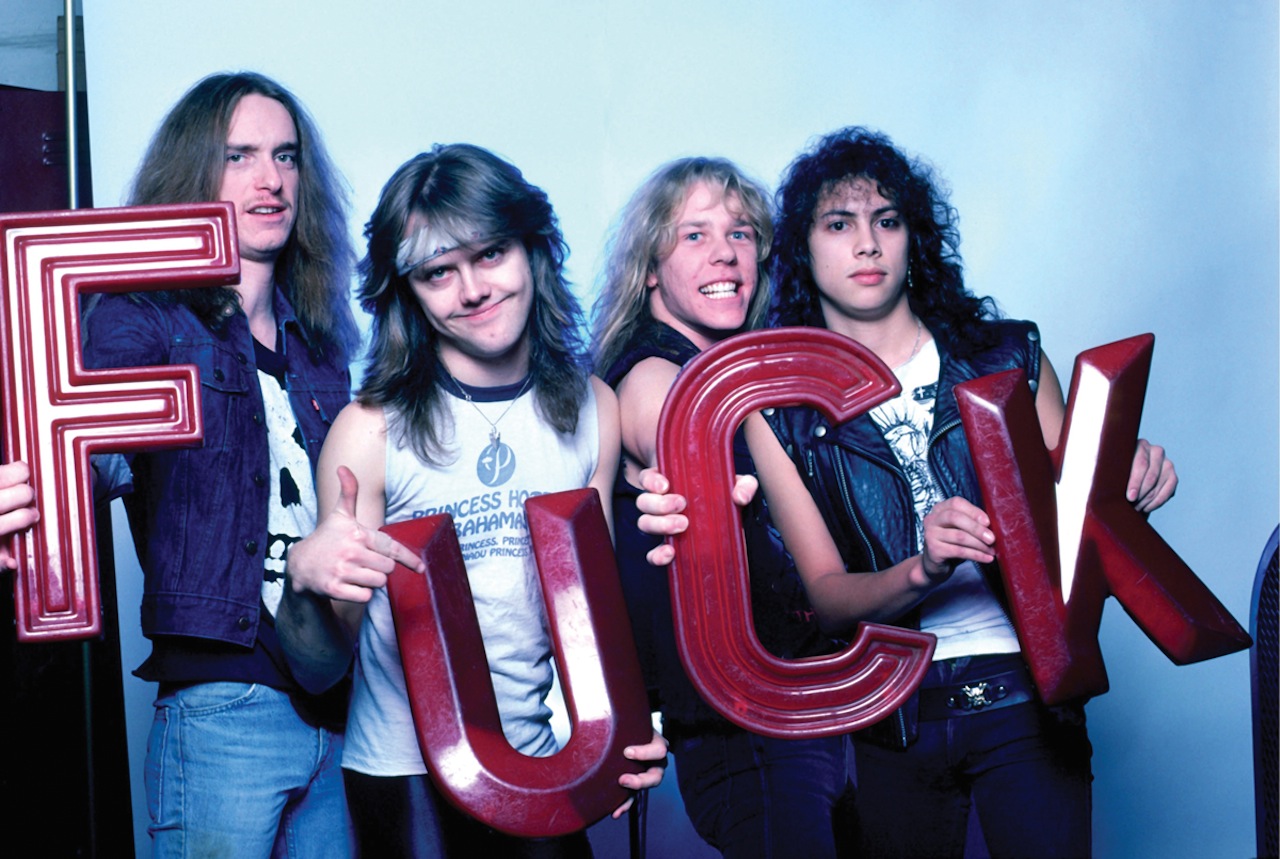
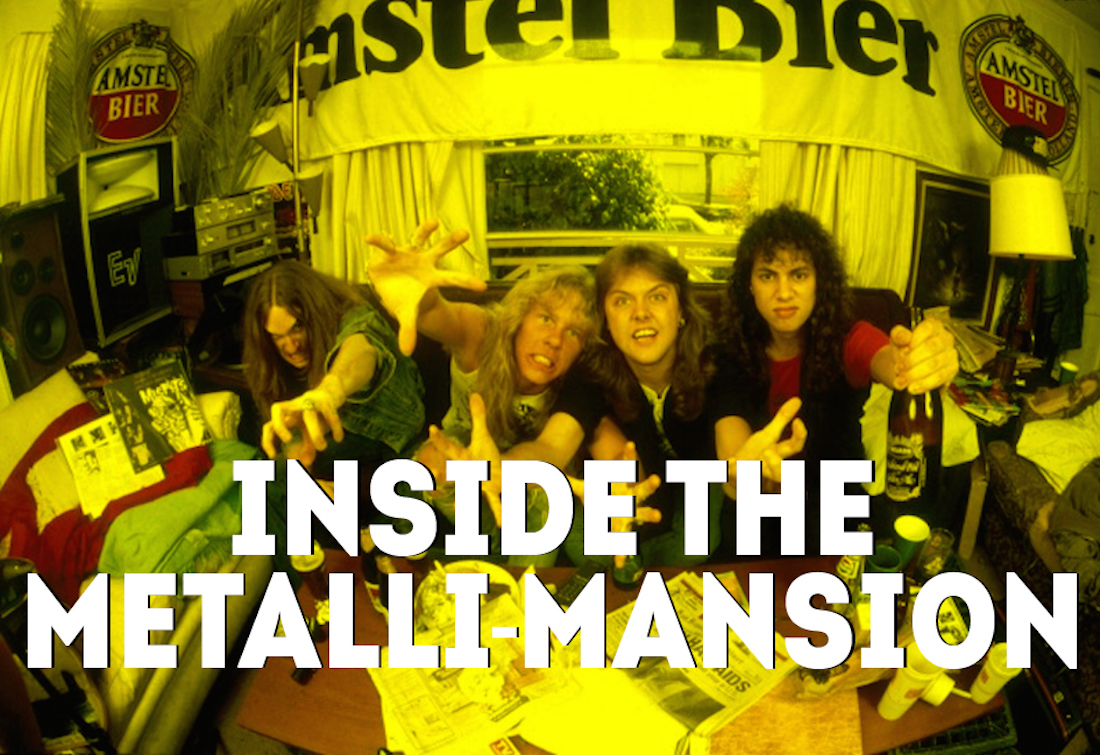
We head inside Metallica’s infamous den for a glimpse at the life of a band set to change it all.
=====================================================================================================================================================================================================================
IRON MAIDEN KILLERS POSTER
It’s no secret that the guys were huge Maiden fanboys, and they wasted no time in pasting some of their favourite artwork all over the Metalli-Mansion’s walls. We approve.
GREAT FROG RINGS
Perhaps metal’s most beloved jewellery chain, Metallica were regulars through The Great Frog’s doors, and James’s various looks throughout the years have always seen him decked out in some of their wares.
MISFITS T-SHIRT
Metallica have famously covered a couple of numbers from the horror punk legends’ back catalogue, and Papa Het would rarely be seen without his favourite band tee during the mid-80s.
AMSTEL BIER BANNER
Well, they were dubbed ‘Alcoholica’ for a reason! Setting the tone for the place they called home for all those months, we can only assume that this was ruthlessly purloined from a festival somewhere…
ENFER MAGAZINE
The June ’85 issue of the French metal mainstay, to be precise, featuring Scorpions on the cover and a feature on the mighty Judas Priest! We can’t imagine what Metallica saw in it…
DAY ON THE GREEN FLIER
One of the US’s biggest festivals that year, Oakland’s Day On The Green featured a glam-flavoured bill that also included Scorpions in their pomp, not to mention sleaze rockers Ratt, Yngwie Malmsteen’s Rising Force and Y&T!
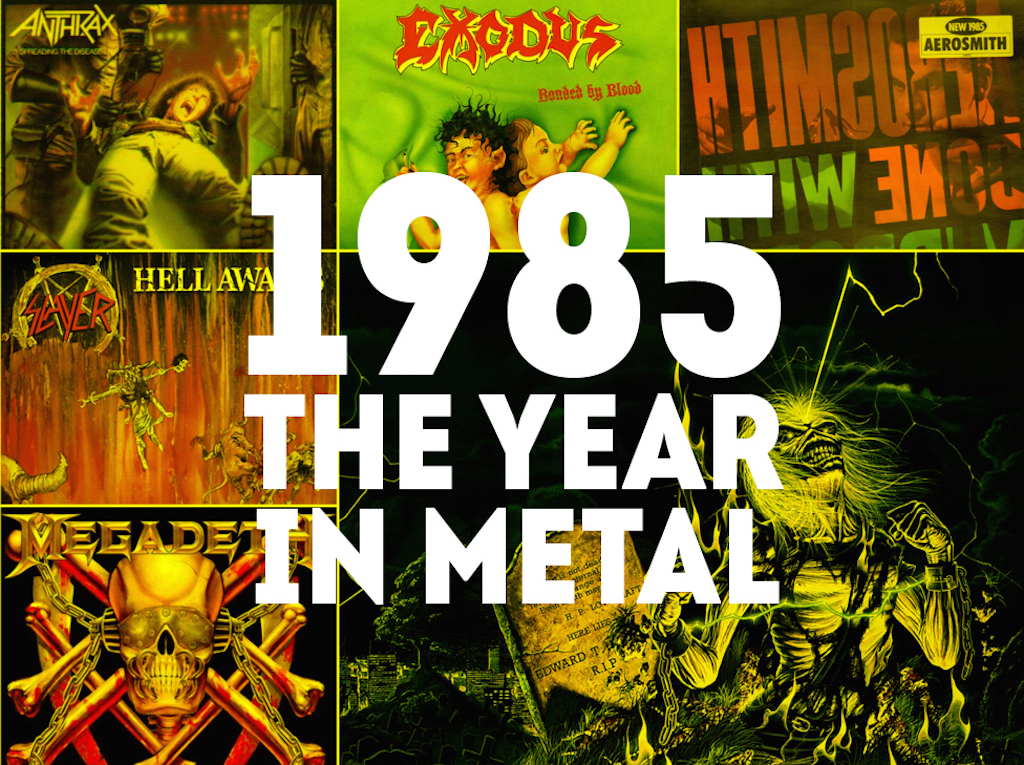
<!–[if gte mso 9]>
0 0 0
1985 WAS A HUGELY SIGNIFICANT 12 MONTHS FOR OUR WORLD. HERE ARE 10 KEY EVENTS FROM THAT YEAR THAT HELPED TO SHAPE THE FACE OF HEAVY MUSIC…
_
_
DAVID LEE ROTH WALKS OUT OF VAN HALEN
Van Halen’s sixth studio (styled as MCMLXXXIV on its front cover) turned the Pasadena party-metal quartet into the biggest rock band in the world… and gave motormouth frontman David Lee Roth the perfect platform to quit the band and strike out on his own. He’d be back…
ZEPPELIN AND SABBATH REFORM
Well, for one day at least. Whether incentivised by Bob Geldof’s stirring words or simply by the opportunity to perform to a global TV audience numbered in the tens of millions, Led Zep and Black Sabbath regrouped to play Philadelphia’s John F. Kennedy Stadium on July 13, 1985. Neither act covered themselves in glory; indeed, Zeppelin’s performance was so shoddy that stand-in drummer Phil Collins considered walking off-stage mid-set.
AEROSMITH’S CLASSIC LINEUP RETURNS TOO
Ego clashes and drug-fuelled arguments caused Joe Perry and Brad Whitford to walk away from Aerosmith, but in ’85 the old gang came together for the Done With Mirrors album. In truth, the comeback was underwhelming: two years later, with Permanent Vacation, the magic truly returned.
‘MOST DANGEROUS BAND IN THE WORLD’ FORM
Guns N’ Roses formed in the spring of 1985, when Hollywood Rose’s Axl Rose and guitarist Izzy Stradlin joined forced with three members of LA Guns. By June, Slash, Duff McKagan and Steven Adler replaced the LA Guns alumni, and a new chapter in rock history began.
LONG BEACH SCREAMS FOR IRON MAIDEN
On July 5, Iron Maiden’s epic 11-month tour in support of Powerslave drew to a close at Irvine Meadows Amphitheatre. Three months later, Live After Death, a brilliant document of the trek, culled from shows at Long Beach Arena and Hammersmith Odeon, was released, and Bruce’s iconic “Scream for me, Long Beach!” entreaties became enshrined in metal folklore.
THRASH METAL COMES OF AGE
Bonded By Blood. Killing Is My Business… And Business Is Good. Spreading The Disease. Hell Awaits. Four thrash classics that proved Metallica weren’t the only ones perfecting the form.
PMRC TARGET ‘OBSCENE’ METAL
The PMRC (Parents Music Resource Center) was founded in 1985 to lobby for more parental control over kids’ access to music which ‘glorified’ violence, substance abuse and sexual congress: the group targeted metal and female pop artists on its Filthy Fifteen list of objectionable songs. Their efforts led to a memorable Senate appearance from Twisted Sister’s Dee Snider and the introduction of ‘Parental Advisory’ stickers on albums with ‘explicit’ themes.
POSSESSED GIVE US DEATH METAL
Two years ahead of Death’s Scream Bloody Gore, San Francisco teenagers Possessed unleashed Seven Churches, a brutal bridge between thrash and the nascent death metal scene. It still sounds savage.
JESUS GETS METAL DISCIPLES
The arrival of Christian Metal act Stryper, whose first full-length album Soldiers Under Command emerged in May 1985, confused the fuck out of metal audiences. The LA quartet threw Bibles out at gigs, referred to Jesus as ‘The Rock That Makes Me Roll’ and played metal so sickly and sweet that just looking at their albums causes toothache.
PANTERA RELEASE I AM THE NIGHT
Who could forget the timeless Hot And Heavy, the mighty Onward We Rock! and the thrilling Valhalla?! I Am The Night would be Pantera’s final album with vocalist Terry Glaze: the recruitment of Metallica-loving vocalist Phil Anselmo would lead to a new blueprint for metal for the decades to come…/o:p
<!–[if gte mso 9]>
0 0 0
STATTERY
All the crucial fact bombs that made Metallica’s year such a classic…
118: Days spent in the studio recording Master Of Puppets. Worth the wait, we reckon.
100: Position Ride The Lightning peaked at on the Billboard 200 that March.
Fight Fire With Fire: First song played live in ‘85 (Jan 10, NY).
Blitzkrieg: Last song played live in ‘85 (Dec 31, CA).
57: Total number of shows played by Metallica across 1985. An average of one every 6.4 days!
2: Covers recorded during the Puppets sessions with Cliff - Diamond Head’s The Prince and Misfits’ Green Hell! Neither were officially released.
February 9: Date Metallica played Fade To Black for the first time. Despite being thrash’s first ‘ballad’, it went down pretty well!
55,000: Number of punters estimated to be at Donnington that summer.
Denver, Colorado: Location of the hotel Metallica caused to be evacuated that summer after setting off a ton of fire alarms. Naughty.
1: Number of pig heads thrown onstage during their set at Donnington. Poor bastard.
3132: Address of the Metallica Mansion on Carlson Boulevard and the spiritual home of Bay Area partying. We’re hungover just thinking about it.
To test your Metallica smarts, then click on the link below.

A music writer since 1993, formerly Editor of Kerrang! and Planet Rock magazine (RIP), Paul Brannigan is a Contributing Editor to Louder. Having previously written books on Lemmy, Dave Grohl (the Sunday Times best-seller This Is A Call) and Metallica (Birth School Metallica Death, co-authored with Ian Winwood), his Eddie Van Halen biography (Eruption in the UK, Unchained in the US) emerged in 2021. He has written for Rolling Stone, Mojo and Q, hung out with Fugazi at Dischord House, flown on Ozzy Osbourne's private jet, played Angus Young's Gibson SG, and interviewed everyone from Aerosmith and Beastie Boys to Young Gods and ZZ Top. Born in the North of Ireland, Brannigan lives in North London and supports The Arsenal.
